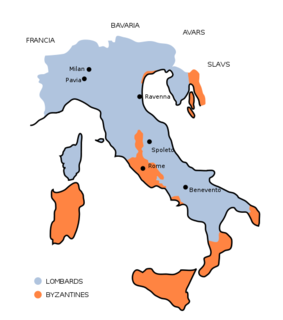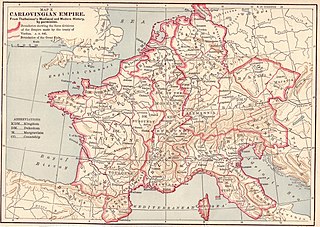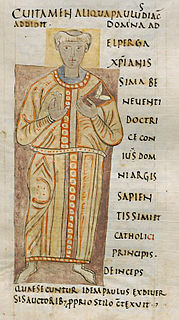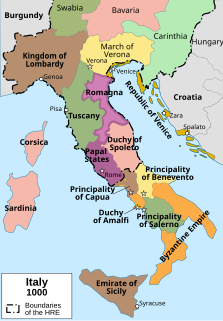
Aistulf was the Duke of Friuli from 744, King of Lombards from 749, and Duke of Spoleto from 751. His father was the Duke Pemmo.

The Duchy of Benevento was the southernmost Lombard duchy in the Italian peninsula, centered on Benevento, a city in Southern Italy. Being cut off from the rest of the Lombard possessions by the papal Duchy of Rome, Benevento was practically independent from the start. Only during the reigns of Grimoald, King of the Lombards and the kings from Liutprand on was the duchy closely tied to the kingdom. After the fall of the kingdom, however, alone of Lombard territories it remained as a rump state, and maintained its de facto independence for nearly three hundred years, though it was divided after 849.

Pandulf I Ironhead was the Prince of Benevento and Capua from 943 until his death. He was made Duke of Spoleto and Camerino in 967 and succeeded as Prince of Salerno in 977 or 978. He was an important nobleman in the fight with the Byzantines and Saracens for control of the Mezzogiorno in the centuries after the collapse of Lombard and Carolingian authority on the Italian Peninsula. He established himself over almost the whole of the southern half of Italia before his death in March 981.
Ariulf was the second Duke of Spoleto from 592 to his own death.
Transamund II was the Lombard Duke of Spoleto from 724 to 745, though he was twice driven from power by the king, Liutprand. Transamund rose to power by deposing his own father, Faroald II, and tonsuring him in a monastery.
Hilderic was the Lombard Duke of Spoleto briefly from 739 to 740. He was the first appointee of Liutprand, King of the Lombards, against the rebellious Thrasimund II.

Liutprand was the duke of Benevento from the death of his father Gisulf II in 751 until his own deposition. He reigned under the regency of his mother, Scauniperga, who supported King Aistulf, until 756.
Faroald I was the first Duke of Spoleto, which he established during the decade of interregnum that followed the death of Alboin's successor. He led the Lombards into the centre of the Italian peninsula while Zotto led them into the south.

The Kingdom of the Lombards also known as the Lombard Kingdom; later the Kingdom of (all) Italy, was an early medieval state established by the Lombards, a Germanic people, on the Italian Peninsula in the latter part of the 6th century. The king was traditionally elected by the highest-ranking aristocrats, the dukes, as several attempts to establish a hereditary dynasty failed. The kingdom was subdivided into a varying number of duchies, ruled by semi-autonomous dukes, which were in turn subdivided into gastaldates at the municipal level. The capital of the kingdom and the center of its political life was Pavia in the modern northern Italian region of Lombardy.
Thrasimund I or Transamund I was the Count of Capua and then Duke of Spoleto, a faithful follower of Grimoald I of Benevento.
Agiprand was briefly the Duke of Spoleto between 742 and 744.
Theodicius was the Duke of Spoleto from 763 to 773. Though it is often stated that he died at the Siege of Pavia (774), he was still alive on 9 June 776, when Charlemagne confirmed the properties of the monastery of Farfa and Abbot Ingoald in the reign of his successor Hildeprand.

The Duchy of Friuli was a Lombard duchy in present-day Friuli, the first to be established after the conquest of the Italian peninsula in 568. It was one of the largest domains in Langobardia Major and an important buffer between the Lombard kingdom and the Slavs, Avars, and the Byzantine Empire. The original chief city in the province was Roman Aquileia, but the Lombard capital of Friuli was Forum Julii, modern Cividale.
Unulf was possible a Duke of Spoleto briefly in 752. He is recorded to have reigned for a few years, but this is uncertain. Aistulf, the king, took the duchy into his hands sometime after the death of Lupus.

The March of Friuli was a Carolingian frontier march, established in 776 as the continuation of the Lombard Duchy of Friuli, established against the Slavs and Avars. It was ceded to the Duchy of Bavaria as the March of Verona in 952. Its territory comprised the parts of modern-day Italy, Slovenia and Croatia.

Adelperga was a Lombard noblewoman, daughter of Desiderius, King of the Lombards, and his wife Ansa. She was the third of four daughters of King Desiderius. Her elder sister Desiderata was a wife of Charlemagne.
Wandelbert was the Abbot of Farfa sometime between 757 and 761, one of a series of abbots from Aquitaine. His abbacy coincided with a troubled period in the abbey's history and the stormy reign of Duke Gisulf of Spoleto, who seems to have brought some stability to the abbey by the time of his death.
Probatus was the Abbot of Farfa from 770 until 781, and the first abbot native to the Sabina. He steered the abbey through the fall of the Kingdom of the Lombards, trying to prevent the disastrous aggression of its last king, and kept it from falling under the jurisdiction of either the Papacy or the Papal States. With the benefit of his local connections he oversaw a great expansion of the abbey's properties through grants and purchases, and also rationalised its holdings to create a robust base for an early medieval monastic community.










